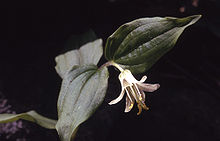| Streptopoideae | |
|---|---|
 | |
| Prosartes trachycarpa | |
| Scientific classification | |
| Kingdom: | Plantae |
| Clade: | Tracheophytes |
| Clade: | Angiosperms |
| Clade: | Monocots |
| Order: | Liliales |
| Family: | Liliaceae |
| Subfamily: | Streptopoideae Mabb. ex Reveal [1] |
| Genera | |
See here | |
The Streptopoideae are a subfamily of monocotyledon perennial, herbaceous, mainly bulbous shade dwelling flowering plants in the lily family, Liliaceae. The subfamily includes three genera.


